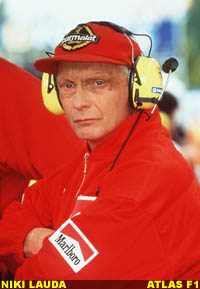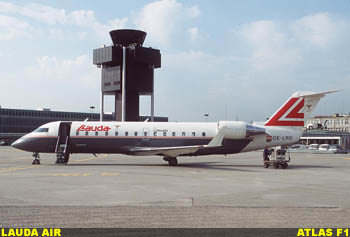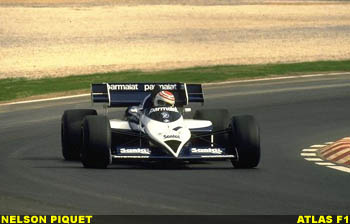There is a well known English saying, "life begins at forty."
However, for today's Grand Prix drivers, a more appropriate
saying might be, "a second life begins at forty," for that's
about the age that most Formula One stars think about hanging up
their helmet and retiring -- at least from the young man's sport
of Grand Prix racing.
Like most other world class sports, Formula One racing can be
cruel. However, the cruelty is not limited to the danger a driver must
face every time he takes to the track. After probably a decade or
more in the limelight as a top line driver or even a World
Champion, Grand Prix teams will not hesitate to push one of their
drivers aside if they think a younger man can do a better job.
 Some drivers hang on to their careers as long as they can until
finally there are no doors left open for them. Others choose to
step down gracefully while at the top of their careers
rather than hold on too long, discovering they are no longer
wanted. Some drivers hang on to their careers as long as they can until
finally there are no doors left open for them. Others choose to
step down gracefully while at the top of their careers
rather than hold on too long, discovering they are no longer
wanted.
Either way, every driver is faced with the inevitable task of
finding another way of spending the rest of their life. A
decision which is not an easy one if you consider the glamour and
the excitement that has been an every-day part of their lives up
to that point. The fact that most of them do not have any
other trade than driving cars extremely fast makes the task even harder. However,
for the past decade or so, many of the F1 drivers quitting the
sport have done so with enough zero's at the end of their bank
balance not to have to worry about feeding themselves for the
rest of their lives.
It's a position that most of us would
relish, but its not usually the financial situation that gives a
driver the most anguish at the end of his Formula One career.
It's learning to cope with no more traveling from country to
country, hectic testing schedules, constant racing schedules, never-ending sponsor commitments and
press appointments. Basically, it's the withdrawal from the rush given with constant lack of time.
The day a driver retires, he will suddenly have as many days off as
he wants. It's a situation that will certainly be a welcome one for a few months, but after
that, boredom sets in. Because of a racing driver's natural
competitive spirit, most are soon looking for fresh challenges,
usually away from the cockpit of a racing car.
 One of the best know success stories is, of course, the former
Austrian World Champion, Niki Lauda. Niki was bitten by the flying bug
when he was flying himself between races and places with his own
Lear jet and took his passion for flying one step further when
he quit racing and started up his own airline - Lauda Air. In his
usual hands-on style, Niki became qualified to fly all the planes
that his airline operated and would often give his passengers an
extra thrill to know that they were being flown to their holiday
destination by none other than the triple World Champion himself. One of the best know success stories is, of course, the former
Austrian World Champion, Niki Lauda. Niki was bitten by the flying bug
when he was flying himself between races and places with his own
Lear jet and took his passion for flying one step further when
he quit racing and started up his own airline - Lauda Air. In his
usual hands-on style, Niki became qualified to fly all the planes
that his airline operated and would often give his passengers an
extra thrill to know that they were being flown to their holiday
destination by none other than the triple World Champion himself.
In just a few years, Lauda Air has grown into a highly successful
airline into which both Lufthansa and Austrian Airlines have
bought an interest, underlining their confidence in Niki as a
businessman as much as a pilot and racing driver. Despite running
his own airline, Niki was also able to keep in contact with F1 by
way of a promotion contract for Ferrari and adviser to his former
Team Manager and now Ferrari boss, Luca di Montezemolo.
Lauda was one of the first racing drivers to reach "superstar"
with super salary status. However, he had to
"un-retire" himself for another couple of seasons to help his
struggling airline to survive in its early days even though he earned more out of
motor racing than any of his predecessors at the time.
Ferrari's last World Champion, South African born Jody Scheckter,
was only 31 when he decided to quit the sport at the end of 1980
after taking the World Championship in 1979 ahead of his own
team-mate Gilles Villeneuve.
 "I had a terrible year in 1980 because the car wasn't any good
and I wasn't getting the same thrill out of motor racing as I had
before I was World Champion. I had achieved what I wanted and
suddenly realized that the challenge and excitement had gone out
of it for me. I needed something new in my life," recounts Jody. "I had a terrible year in 1980 because the car wasn't any good
and I wasn't getting the same thrill out of motor racing as I had
before I was World Champion. I had achieved what I wanted and
suddenly realized that the challenge and excitement had gone out
of it for me. I needed something new in my life," recounts Jody.
He quit his high profile life-style to live an unknown
existence in the USA where he had aspirations of becoming a
tennis professional, but when he realized that wasn't going to
work out, he too was faced with the biggest challenge yet: what
to do with the rest of his life.
"I was reading a magazine and saw an advertisement for a firearms
training simulator. It involved firing real bullets and I
thought there must be a more practical way of doing the same
thing with 'Laser' bullets, which could be linked to a computer
for scoring etc.," recalls Jody.
He invested nearly all the money he had earned in motor racing,
plus more money from a couple of outside investors he had known
from Monaco, to set about turning his idea into reality. Twelve
years later, his company Firearms Training Systems - FATS - had
gone from a couple of guys working on his kitchen table to a
multi-million dollar operation based in Atlanta with over 250
employees.
Last year, the company went public and Jody "retired" for a
second time - a lot richer than the first time - and has moved
back to London with his second wife Clair and their two young
boys.
"For the moment I am taking a few months holiday and helping my
other two older boys Toby and Thomas start their racing careers,"
says Jody. "After that, who knows? I will be looking for
something else to do, maybe running a racing team for them if
they do well."
>
 Some 13 years later than Jody, quadruple World Champion Alain Prost was faced with the same
dilemma when he quit F1 in 1993. He got involved in his son's
karting career, went to Grand Prix races as a TV commentator and
even returned to the cockpit as a test driver and adviser for the
McLaren Mercedes team. Despite that, he still felt an outsider in
a sport that had seemed to revolve around him for so many years
as he became the driver with the most Grand Prix victories in the
history of the sport.
Some 13 years later than Jody, quadruple World Champion Alain Prost was faced with the same
dilemma when he quit F1 in 1993. He got involved in his son's
karting career, went to Grand Prix races as a TV commentator and
even returned to the cockpit as a test driver and adviser for the
McLaren Mercedes team. Despite that, he still felt an outsider in
a sport that had seemed to revolve around him for so many years
as he became the driver with the most Grand Prix victories in the
history of the sport.
He wanted the same sort of total involvement and thrill that he
had found as a driver, which he has finally found when he took
over the ownership of the Ligier team, now Prost Formula One, at
the start of the 1997 season. "It's more nerve wrecking as a team
owner standing on the pit wall than it ever was as a driver,"
says Prost. The Frenchman now relishing his new role which he
also describes as, "A lot harder work as well."
Ironically, 24 years after he decided to quit Formula One,
another former triple World Champion, Jackie Stewart, has
returned to the pit wall as a team owner with the Stewart-
Ford team. His son Paul also plays a leading role in the team
after giving up hopes of being a successful driver himself to
manage his own teams in the lower category formula before joining
his father in their F1 project.
 Since retiring in 1973, Jackie Stewart has made a sizeable
fortune doing promotion work for a long list of prestige
companies. It was these and other contacts gained over the years
that have also helped him to find the huge sponsorship necessary
to launch his own F1 team from scratch. Since retiring in 1973, Jackie Stewart has made a sizeable
fortune doing promotion work for a long list of prestige
companies. It was these and other contacts gained over the years
that have also helped him to find the huge sponsorship necessary
to launch his own F1 team from scratch.
Some drivers have not found it as easy to make the break from
Formula One as all those mentioned. Nigel Mansell announced his
retirement from F1 while driving for Ferrari, but then returned
to Williams the following season, with whom he finally won his
first World Championship title in 1992. He then quit F1 at the
end of that year after a dispute over his 1993 terms, but then
went to race in the USA where he also won the CART championship
in 1993. After another season, he then quit that series to make
another return to F1 with Williams for a few races at the end of
the 1994 season.
He got an offer to drive for McLaren in 1995, but that
drive only lasted a couple of races before he quit the team,
deciding to concentrate on the development of a newly acquired
golf and country club in Southern England. There was even talk of
yet another come-back with Jordan-Peugeot in 1997, but after a
brief test and long financial discussions he eventually announced
that he had decided to devote his time to his golf club and to
playing golf, a sport in which he also excels. Nowadays, Mansell drives in the British Touring Cars series, with little success though.
Mansell's former team-mate and triple World Champion Nelson
Piquet had no problems changing his life style when he retired,
although the decision was partly made for him after he suffered a
major accident while practicing for the Indianapolis 500 race in
1993, the year after he retired from Benetton.
 He has since recovered and made another one-off appearance at
Indianapolis and has also driven successfully is several sports
car and saloon car races for BMW. "Just for fun," says Nelson,
who now lives full-time in his native Brazil and devotes most of
his time to a business into which he has sunk most of his F1
earnings. He has since recovered and made another one-off appearance at
Indianapolis and has also driven successfully is several sports
car and saloon car races for BMW. "Just for fun," says Nelson,
who now lives full-time in his native Brazil and devotes most of
his time to a business into which he has sunk most of his F1
earnings.
"It's a satellite tracking system for trucks or boats, which is
constantly linked with a central base that can also send messages
via satellite to the vehicle. In a country the size of Brazil, it
means you can operate more efficiently and, of course, know
exactly where your truck is should it be stolen," says Nelson,
whose business is now starting to show a healthy profit. He is
also involved in kart racing with his son and the running of both
his home Brazilian race track and, more recently, the Rio track as
well.
South of the Brazilian border, former F1 star Carlos
Reutemann has one of the most unusual post-race careers. After
returning to his native Argentina to take up his second love of
farming on his Santa Fe ranch, he has also taken up politics and
is now the governor of the Santa Fe region. He is even tipped by
many to be the next likely candidate to become President in the
years ahead!
And for those other ex-Grand Prix drivers that don't have such
high aspirations for their future, there is always the
television. Not sitting at home and watching it, but commenting
for their national stations, a job which has become a stepping
stone for many while they find their feet in "civilian" life.
 World Champion Keke Rosberg was a regular visitor to the circuits after he retired as a driver and
did the commentary for German TV. He then started his own Opel
touring car team (for which he also drove for a time) and also
took up driver management a his new profession, closely nurturing the career of this year's title leader, Mika Hakkinen. Another former World Champion, Alan Jones, has also taken to tin-top racing with
his own team in his native Australia, but keeps in touch with GP
racing speaking from the studio for Australia's Channel 9 TV. World Champion Keke Rosberg was a regular visitor to the circuits after he retired as a driver and
did the commentary for German TV. He then started his own Opel
touring car team (for which he also drove for a time) and also
took up driver management a his new profession, closely nurturing the career of this year's title leader, Mika Hakkinen. Another former World Champion, Alan Jones, has also taken to tin-top racing with
his own team in his native Australia, but keeps in touch with GP
racing speaking from the studio for Australia's Channel 9 TV.
Ex-Ferrari men Rene Arnoux and Patrick Tambay are both regular TV
talkers as is former McLaren driver John Watson. Jonathan Palmer, Jacques Laffite, Martin Brundle, Jochen Mass and
Marc Surer and Ivan Capelli all have steady TV jobs to keep them
involved in the sport as well as their other interests.
Twice World Champion Emerson Fittipaldi gets the long service
award. After winning the F1 Drivers Championship in 1972 for
Lotus and then in 1974 for McLaren, he had little
success driving his own F1 car from 1976 to 1980. Heavily in
debt, he gave up F1 and settled in the USA to start a second
successful career in Indy cars, from which he retired a year ago, having suffered a couple of back injuries - one from a racing accident and another a year later from an ultralight plane crash. Fittipaldi luckily escaped paralysis and announced his retirement from 30 years of racing, with his latest achievements being two Indy 500 and Cart Championship wins.
|